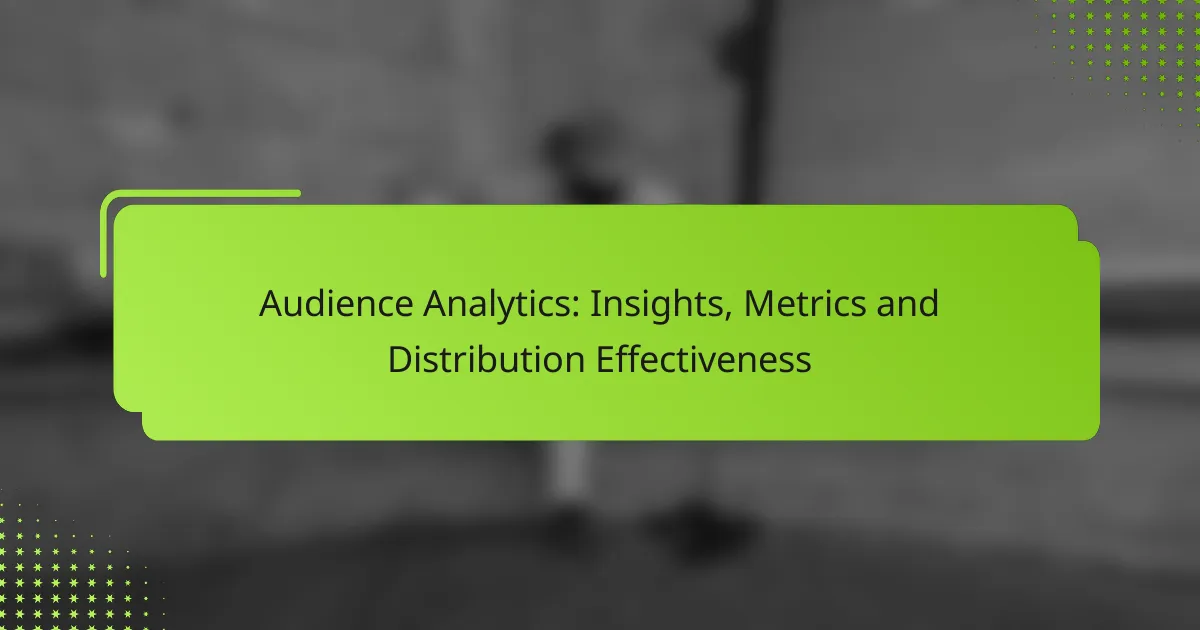Audience analytics plays a crucial role in enhancing the effectiveness of display advertising by offering valuable insights into consumer behavior and engagement patterns. By analyzing key metrics such as engagement and conversion rates, businesses can tailor their campaigns to reach the right audience at the optimal time, leading to improved performance. Furthermore, leveraging these insights allows for optimized ad distribution, ensuring that marketing strategies resonate with target demographics and drive higher conversion rates.

How can audience analytics improve display advertising effectiveness?
Audience analytics enhances display advertising effectiveness by providing insights into consumer behavior, preferences, and engagement patterns. This data allows advertisers to tailor their campaigns, ensuring that ads reach the right audience at the right time, ultimately leading to better performance and higher conversion rates.
Enhanced targeting capabilities
Enhanced targeting capabilities enable advertisers to focus their efforts on specific demographics, interests, and behaviors. By analyzing audience data, advertisers can segment their target market into distinct groups, allowing for personalized messaging that resonates with each segment.
For example, a retailer can use analytics to identify high-value customers and create tailored ads that appeal to their preferences, increasing the likelihood of engagement. Utilizing tools like lookalike audiences can further refine targeting by finding new potential customers similar to existing ones.
Increased ROI through data-driven decisions
Data-driven decisions lead to increased return on investment (ROI) by optimizing ad spend and improving campaign performance. By leveraging audience analytics, advertisers can identify which ads perform best and allocate budgets accordingly, reducing waste on ineffective strategies.
For instance, if analytics reveal that a particular ad format or placement yields higher engagement rates, advertisers can prioritize those options. Regularly reviewing performance metrics allows for ongoing adjustments, ensuring that campaigns remain effective and financially viable.
Improved ad placement strategies
Improved ad placement strategies stem from understanding where and when the target audience is most active. Audience analytics provide insights into the best platforms and times for ad placements, maximizing visibility and engagement.
Advertisers should consider factors such as peak online activity times and preferred devices when planning placements. Testing different ad placements and analyzing performance can help refine strategies, ensuring that ads appear in the most effective contexts for the target audience.

What key metrics should be tracked in audience analytics?
Key metrics in audience analytics include engagement rates, conversion rates, demographic insights, and traffic sources. Tracking these metrics helps businesses understand their audience’s behavior, preferences, and the effectiveness of their marketing strategies.
Engagement rates
Engagement rates measure how actively users interact with your content, typically expressed as a percentage of total visitors. This can include likes, shares, comments, and time spent on a page. A higher engagement rate often indicates that your content resonates well with your audience.
To calculate engagement rates, divide the total interactions by the total reach or impressions, then multiply by 100. For example, if a post receives 200 interactions from 1,000 impressions, the engagement rate is 20%. Aim for engagement rates in the low to mid-teens for social media platforms.
Conversion rates
Conversion rates indicate the percentage of users who complete a desired action, such as making a purchase or signing up for a newsletter. This metric is crucial for assessing the effectiveness of your marketing campaigns and website design. A typical conversion rate for e-commerce sites ranges from 1% to 3%.
To improve conversion rates, focus on optimizing landing pages, simplifying the checkout process, and using clear calls to action. Regularly testing different elements, like headlines and images, can help identify what drives conversions effectively.
Demographic insights
Demographic insights provide information about the characteristics of your audience, such as age, gender, location, and interests. Understanding these factors allows businesses to tailor their content and marketing strategies to better meet the needs of their target audience.
Utilize tools like Google Analytics or social media insights to gather demographic data. For instance, if your audience is primarily composed of young adults aged 18-24, consider creating content that appeals specifically to their interests and preferences.
Traffic sources
Traffic sources indicate where your website visitors are coming from, such as organic search, paid ads, social media, or referrals. Analyzing these sources helps identify which channels are most effective for driving traffic and conversions.
To track traffic sources, use analytics tools that categorize visitors by source. For example, if a significant portion of your traffic comes from social media, consider investing more in social media marketing. Regularly reviewing traffic sources can help you allocate resources more effectively and adjust strategies as needed.

How to leverage audience insights for better ad distribution?
Leveraging audience insights for ad distribution involves understanding your target demographics and tailoring your campaigns accordingly. By analyzing audience behavior and preferences, you can optimize ad placements and formats to enhance engagement and conversion rates.
Utilizing segmentation strategies
Segmentation strategies involve dividing your audience into distinct groups based on shared characteristics such as demographics, interests, or behaviors. This allows for more personalized ad experiences, which can significantly improve response rates.
Consider using tools like Google Analytics or social media insights to identify key segments. For instance, targeting younger audiences with mobile-friendly ads can lead to higher engagement compared to generic ads aimed at a broader audience.
Implementing retargeting campaigns
Retargeting campaigns focus on re-engaging users who have previously interacted with your brand but did not convert. By serving ads to these users across different platforms, you can remind them of your offerings and encourage them to return.
Effective retargeting can increase conversion rates by a significant margin, often in the range of 10-30%. Use platforms like Facebook Ads or Google Ads to set up retargeting lists based on user behavior, such as website visits or abandoned carts.
Optimizing ad formats based on audience behavior
Ad format optimization involves selecting the most effective types of ads based on how your audience interacts with content. Analyzing metrics such as click-through rates and engagement can guide your decisions on whether to use video, carousel, or static ads.
For example, if your audience shows a preference for video content, investing in short, engaging video ads can yield better results. Regularly test different formats and analyze performance to refine your approach and maximize effectiveness.

What tools are essential for audience analytics?
Essential tools for audience analytics include platforms that provide insights into user behavior, demographics, and engagement metrics. These tools help businesses understand their audience better and optimize their marketing strategies accordingly.
Google Analytics
Google Analytics is a powerful tool that tracks website traffic and user interactions. It provides data on user demographics, behavior, and conversion rates, allowing businesses to analyze how visitors engage with their content.
To get started, set up a Google Analytics account and integrate it with your website. Monitor key metrics such as bounce rate, session duration, and user flow to identify areas for improvement. Regularly review these metrics to adapt your strategies based on user behavior.
Facebook Audience Insights
Facebook Audience Insights offers valuable data about users on the platform, including their interests, demographics, and behaviors. This tool is particularly useful for businesses looking to target specific audiences with their ads.
Access Audience Insights through your Facebook Ads Manager. Use it to create detailed audience segments based on location, age, gender, and interests. This data can inform your content strategy and help tailor your advertising efforts for better engagement.
Adobe Analytics
Adobe Analytics provides comprehensive insights into customer journeys across multiple channels. It allows businesses to track user interactions in real-time and analyze data to enhance customer experiences.
Implement Adobe Analytics by integrating it with your digital platforms. Focus on key performance indicators (KPIs) such as customer lifetime value and conversion rates. Utilize its advanced segmentation features to gain deeper insights into specific audience behaviors and preferences.

What are the prerequisites for effective audience analytics?
Effective audience analytics requires a solid foundation of data collection, integration capabilities, and a clear understanding of your target audience. Establishing these prerequisites ensures that insights gained are accurate, actionable, and relevant to your marketing strategies.
Data collection methods
Data collection methods are essential for gathering insights about your audience. Common techniques include surveys, web analytics, social media monitoring, and customer feedback forms. Each method provides unique insights, so it’s crucial to choose a combination that aligns with your goals.
For instance, web analytics tools can track user behavior on your site, while social media monitoring can reveal audience sentiment and engagement levels. Aim to collect both quantitative data (like page views) and qualitative data (like user comments) for a well-rounded view.
Integration with advertising platforms
Integrating audience analytics with advertising platforms enhances the effectiveness of your campaigns. This integration allows for real-time data sharing, enabling marketers to adjust strategies based on audience behavior and preferences. Popular platforms like Google Ads and Facebook Ads offer built-in analytics tools that can streamline this process.
When integrating, ensure that your data sources are compatible and that you have the necessary permissions to share data across platforms. Regularly review your integration setup to avoid data silos and ensure that insights are actionable and timely.



